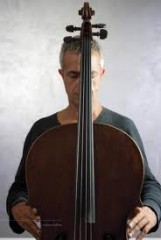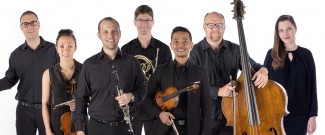A Cello And A Chair: Giovanni Sollima Tours With The Australian Chamber Orchestra

Giovanni Sollima surmises that if he landed on earth from another world and were handed a cello without being told what it was, he would probably use it to sail in.
An interesting abstraction from the virtuoso Italian cellist who is touring with the Australia Chamber Orchestra this month. The cello as a sailing vessel can contain a myriad experiences and journeys and set its own direction or be borne by the elements around it.
Sollima has a reputation for pushing the boundaries of this ancient instrument – he believes the cello case is an integral part of the apparatus with its own sonic properties; he might walk around on stage whilst playing; he has played a cello made of ice atop an igloo; more conventionally, he has composed a concerto for two cellos for himself and fellow cellist Yo-Yo Ma, which was premiered by the Chicago Symphony conducted by Riccardo Muti in January 2014. The Chicago Tribune reported “Sollima may well go down in history as the only composer of consequence after Vivaldi to pen a double cello concerto. It proved to be a knockout showpiece for the combined virtuosity of the composer and his newfound colleague. Ma…”
Speaking to SoundsLIkeSydney in Sydney, I asked him to what extent he considers the cello as an extension of himself. His accent is charming and laced with Italianate vowels, hesitating occasionally as he searches for just the right English word. ” I think it’s not true that we know everything about the cello – we’re still exploring. Of course it is another body but it also a part of my body – I get feedback, I feel the vibrations; part of the sounds goes into the space but also some of it comes back into the body. “
During his tour, Sollima ( who composes only on the cello), will perform the Australian premiere of his signature composition LB Files inspired by Boccherini. It is during this work that he will, if the moment is right, take to strolling around the stage whist playing. ” Of course I play classical cello in the conventional position. In baroque times it was played in many different positions – without a chair, with a belt. The position we use today is from the late 1800’s. Walking around during the LB Files is not a requirement in the score. It is an improvisation – an option depending on several things. Sometimes I play walking around for acoustic reasons, or if the mood of the music demands it. Sometimes I walk around to be more connected with the space.”
Space is indeed a phenomenon close to Sollima’s soul – he confesses a ‘little secret’ that had he not become a cellist he would have pursued a career in interior design. Like music, design has a past, a present and future that is inextricably linked to the way we conduct our lives. ” In 100 years music performance may have even more connections with the past. We’re already looking at what was. This doesn’t means that we don’t think of the future. I think that like in life, we’re looking for more natural space in music . Ten years ago I used to play with electronic machines – I got rid of all this now and all I need is a chair and cello – and even if there is no chair it doesn’t matter – the cello is enough!”
One element of this retrospection is that Sollima has taken up the viola da gamba. an antecedent of the cello; and when he learns a piece of music, he starts at the source – the earliest edition he can find. “It may be a limitation but it is something I have to do”, adding “when I speak about the past , and about time, it is all blended. It is more dangerous when we have borderlines and walls between the different kinds of music. There are many jazz and rock cellists who come from a background of guitar or bass; and many traditional cellists play rock, bluegrass and jazz.”
Sollima himself loves to improvise. “It is very exciting. There is a real chemistry between me and the audience.” Then comes a realisation “Even concerts where I have to play written music like a Beethoven sonata there is an element of improvisation – timing phrasing, articulation…. this is the most exciting!” he enthuses.
Whilst lesser beings might struggle to play the cello conventionally; Sollima promenades with a cello that is unusually large. He chose his 1679 Ruggieri for acoustic reasons to effectively play the continuo part in opera. Whether it is opera or chamber music, it is the only instrument on which he performs, adding “It’s not about the pressure or the volume or the power, but about the colour – the colour is the most important thing; and when I experiment I like to try everything on this one instrument” he explains.
Francesco Ruggeri, a violin maker of the second half of the 17th century had his workshop in what is now the via Garibaldi in Cremona, the same street in which Stradivarius had his establishment. The previous day there was news of yet another double-blinded study which had sought to assess performers’ ability to tell a Stradivarius from a modern instrument. The topic is replete with so many variables that the practical application of such a study are puzzling. Sollima explains “There are two sides to consider in making a violin – perfect copies of old instruments or the development of a new shape and model using modern techniques – both are interesting. “
He continues ” I ask myself why the best violins came from Italy – I think it is the perfect balance of dryness and humidity. The wood was seasoned by immersion in the canals of Venice for 6 months, then there was the balance – the proportions of the instrument and the third factor was the shape – all perfected over centuries,”
“There are many ‘Strads’ that don’t sound good anymore and many great modern instruments – you cannot generalise.”
Shamistha de Soysa for SoundsLikeSydney©
Giovanni Sollima plays with the Australian Chamber Orchestra in Sydney on April 29 and 30, May 1 and 2, 2014.







